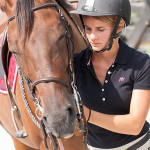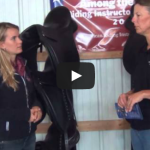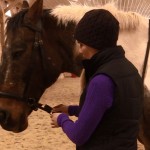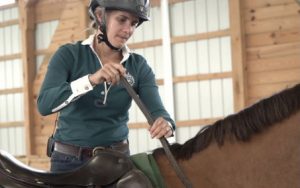For those who are new to the horse world, it may seem as though equestrians speak a different language. There are many unique words and phrases we use to describe our horses and how we ride.
Think about phrases such as “that horse has a lot of action” or “put your leg on.” When we are accustomed to these terms we use them every day without even noticing, but some of what we say sounds pretty strange to an outsider or someone new to the horse world!
In today’s video, I share a list of commonly used terms and what they really mean.
Do you have any words or phrases to add to this list? Put them in the comments below!














27 Responses
Near side (left) and off side (right).
Hi Callie
In previous videos you’ve referred to ‘open hips’ … What does that mean?
Hi Amanda, it means opening the angle from your thigh to your body. Depending on the situation, this may mean sitting straighter or bringing the rider’s leg back.
Nice video Callie explaining “weird” horse language. Another one I thought of during your video, and one that my instructor mentioned to me last week, was “tracking up” as my horse was not doing that as we started the lesson.
I noticed the wood on the barn behind you and it reminded me of a picnic table that we bought years ago that was square and had 4 benches with backs. Must be about 27 years ago but I think that we bought them at King picnic tables on King Road in Honey Brook. That of course was before we moved to Idaho but I loved that table and miss it. Are you any relation? That wood looks JUST like my table!
Very thoughtful and very helpful for the newcomer. Delivered with respect and just the right amount of humor. Thank you, as always!
A term that took me ages to understand (and to dare ask about) is “floating” as it refers to the care of the horse’s teeth. I understand a little better now, but that’s still a weird one to me …
In a lot of for sale ads, I see the horse referred to as ‘in your pocket’. I’m assuming this means the horse is friendly(maybe to the point of being somewhat of a pest!). It would be cool and kind of fun if you could do an analysis of one of these types of ads, because I have a feeling that the words can mean something quite different than we think (like in house for sale ads…..”cute” means small, “handyman’s special” means a hovel, etc.)
There are some really funny horse ads out there! Horse Nation has a column called “Best of Craiglist” – here is one ad titled “Satan for Sale”: http://www.horsenation.com/2014/07/29/best-of-craigslist-satan-for-sale/
The only thing about these ads, as funny as they are, is that we have to hope the horses end up with better owners the second time around!
Chrome is good one….referring to a horse’s white markings. “That horse has a lot of chrome” can refer to a horse typically with a prominent amount of facial and leg markings.
That is a good one!
I wish I had seen this video 3 years ago! I started to volunteer at a horse rescue and the vocabulary drove me nuts! Thanks so so much. You are amazing and I am very grateful for all the knowledge you so kindly share. Thank you
Sonia
I have learned from this site that –hacking–is trail riding.
Yes! Some people also refer to flatwork in a show as a “hack class.” This is usually used with hunters, so I am guessing the term was derived from fox hunting.
Work in hand — referring to ground work
I enjoyed the video and learnt a couple new terms. I kept hoping however that the pop up photos or sketches would stay up longer while you spoke… Maybe your next version of the video or similar videos you could modify. Being able to view the example of what you are talking about for longer helps to solidify the information.
Thanks for the suggestion, Dianne!
Backing a horse. Floating teeth. Cinchy/girthy. Feathers. Mouthy.
Wonderful video! Would love to see some of the riding terms demonstrated on a horse, its often easier to see something rather than try to visualize it from a description. Terms such as “on the bit”, “soft”, “rooting the bit”, “needs to go on the bit”, and “grabbing the bit” I’ve heard but don’t really understand. Of course some of those terms have consequences or are problems, so suggestions how to correct or deal with them would also be great.
Thanks for the questions and suggestions! I could probably do an entire video on “bit” terms!
very well explained. Would really like to know what the different names of jumps mean please – such as oxer, double etc as do get a bit confused as to what they look like.
This would be a great idea for a another blog video!
Very nice video Callie, thank you for all the time and effort you put forth for all of us! Here are some terms I often wonder about; roller, behind/ahead of the movement, cross firing, direct/indirect rein.
Callie – love your videos & posts. Perhaps you could change the heading of the post to “Weird” , which is the correct spelling 😉
Oops! Don’t know how that got missed – thank you!
Thank you! I’m learning so much from you! It’s so nice to have someone explain things to a beginner. It makes me feel so much more comfortable and knowledgeable, and less intimidated around experienced riders.
Hi, Thanks for taking some time explaining those terms. I’m new in horse riding and i learn alot from you today. I can now relate whenever my friends talk about horses. Thanks!
Bravo!